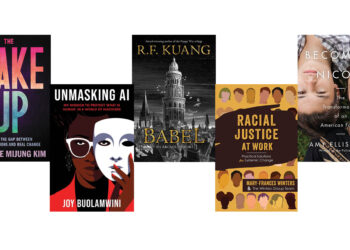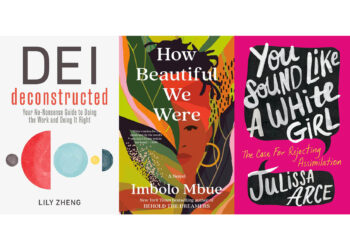As someone who pays attention to the power of how information is framed, I’ve learned to appreciate the power of metaphors. I believe we largely think in metaphors, respond to metaphors, and shape our world while relying on metaphors. Metaphors allow us to understand and, by extension, anticipate new concepts or phenomena. I find them so intriguing that I’ve written three novels with a fictional detective who thwarts criminals through metaphors.
As Orson Scott Card said, “Metaphors have a way of holding the most truth in the least space.”
Research has shown repeatedly that metaphors are somehow closer to the language of our neural zone than we may be able to detect consciously.
A recent study found that people headed up an escalator were more generous when they reached the top, while people headed down were stingy. People who walked up a short flight of stairs were more likely to volunteer than people who walked down a short flight of stairs. And people who were up above others were more considerate of others than people who were below others. “Up” is a metaphor for happiness (upbeat, things are looking up, on the upside) while “down” is a metaphor for disappointment (he’s looking down, there was a downturn, she’s down about her job). A metaphor is translated into the real world.
People who put their lives on the line take metaphors seriously. A story in the Guardian recently discussed the disclosure by the Intelligence Advanced Research Projects Activity (IARPA) that they will be analyzing the metaphors discovered in communications in order to detect potential terrorist activities and discern their plans. As the author of the article writes:
The spooks’ conjecture is that understanding how humans use metaphors might provide an efficient way of extracting meanings from messages. So the project’s goal, says its programme manager, Heather McCallum-Bayliss, is to “exploit the use of metaphorical language to gain insights into underlying cultural beliefs by developing and applying a methodology that automates the analysis of metaphorical language”. Dr McCallum-Bayliss’s presentation explaining the project makes fascinating reading. “Understanding the shared concepts and patterned behaviours of a culture is a significant challenge,” she writes, “because cultural norms tend to be hidden. Even cultural natives have difficulty defining them. Having a system that could discover and structure cultural beliefs and perspectives would be valuable to novice and seasoned analysts alike.”
So I was naturally intrigued when a talk by Kevin Kelly crossed my threshold noting that we’re firmly into the “third metaphor” of computing:
We’re in the middle of a third paradigm of metaphors and organizing principles for personal computers. We’ve moved from desktop and office metaphors, to page/link and web metaphors, to a new metaphor around streams, tags and the cloud. RSS feeds, Facebook walls, Netflix streams are our general drift at present. This accompanies a shift from the me to the we, and from pages and files to data.
This movement from fixed environments to fluidity isn’t all that surprising, as bandwidth has become more and more available, especially as 3G and mobile came together (recently, data showed that 58% of wi-fi users are on mobile devices).
Yet we encounter clashes of metaphors. Recently, the director of Transformers: The Dark of the Moon, Michael Bay (eponymous source of the appropriate neologism, “Bayhem”), was accused of plagiarizing himself, re-using footage of a previous movie, The Island, and re-editing it with bots in place of some of the cars. Yet, in the world of abundance, where does plagiarism end and creative re-use begin? As Kelly notes:
There are 151,000 shots of the Golden Gate Bridge on Flickr – there’s no reason to take one. We will reach a moment where it’s no longer useful to film a flyover shot of the bridge. Eventually, we can curate and reassemble a unique film from that database.
When the metaphor for information was necessarily bounded by physical chunks, re-use implied theft. As the metaphor becomes about streams and flows, re-use becomes about diversion and reintroduction, like a rivulet breaking from the main stream, only to rejoin later with no clear loss of flow. Viewing the Transformers shots derived from those from the Island, you see the similarities, but it’s clear they’re not from the same movie. It’s the world of abundance and remix. When things flow, you can remix them.
News reporting is changing as the metaphors change, as well. O’Reilly Radar reported on MIT’s recent Civic Media Conference, and the data flow phenomenon was clearly at work:
Newsrooms and citizens are confronted by unprecedented amounts of data and an expanded number of news sources, including a social web populated by our friends, family and colleagues. Newsrooms, the traditional hosts for information gathering and dissemination, are now part of a flattened environment for news, where news breaks first on social networks, is curated by a combination of professionals and amateurs, and then analyzed and synthesized into contextualized journalism.
The ambient, ubiquitous computing emerging around us makes Kelly’s metaphor of flow and streams and feeds all the more salient:
A car is a chip with wheels, a shoe is a chip with heels. This isn’t just an internet of things – it’s a database of things. All these words – semantic web, web 3.0 – are describing this data-rich environment filled with these things we make and their data streams.
If your metaphors are still about the desktop, the office, the link, or the page, you might want to reconsider. After all, the metaphors users are embracing are now about streams, flows, clouds, and feeds. And using metaphors to anticipate what’s next, that can only mean computing in the very atmosphere around us — environmental computing.
Will you be ready?
Discussion
3 Thoughts on "Watching the Information World's Metaphors — Are You About Streams Yet?"
The flow of information, especially Internet based flows, is indeed becoming a topic of major interest. IARPA has an RFP out on it. I myself have been doing research on the diffusion of scientific knowledge, and the publisher’s role therein, for 5 years. See for example http://www.dlib.org/dlib/june06/wojick/06wojick.html and other stuff at http://www.osti.gov/innovation/research/diffusion/links
We are sneaking up on being able to see the scientific frontier in motion.
Great post on a critically important topic. I’ve long thought that metaphors are fundamentally how we make sense of reality, which is otherwise too vast, rich, complex, ambiguous, and random to grasp. People tend to brush off metaphor as “poetic” or an oversimplification, but I think it’s actually _how_ we understand, relate to, and manage to live in the real world. Metaphor is a central mechanism by which language evolves because it is a fundamental aspect of how our brains work.
As for the new cloud/stream/flow metaphor, that is absolutely spot-on. People are often trapped in metaphors because they don’t even realize they’re metaphors. I vividly remember how mystified I was when I first saw a GUI with a desktop metaphor (Apple Lisa). I could practically feel the metaphor change in my brain: it looked at first like a jumble of disorganized and fragmented text because my prevailing metaphor was the green-screen command-line interface; suddenly, almost magically, I could “see” documents on a desktop.
This brings to mind another related metaphor transition. (Actually, I shouldn’t imply one replacing the other: these two metaphors _coexist_.) I’m referring to the two fundamental ways we organize information: hierarchies and networks. We have long been trapped in an exclusively hierarchical mode, and we subconsciously judge things that are not “neatly organized” (e.g., able to be represented in a hierarchy) as “disorganized,” “random,” “messy.” This is behind the directory metaphor: files in folders, folders inside other folders. We are currently struggling to break free of that metaphor, and semantics is what’s necessary. In today’s world, we need to be less focused on “where” something is (e.g., what folder did I put that in?) and more focused on “what” it is, and what it relates to.
To close on a geeky note: stay tuned for RDF. People seem apprehensive about RDF right now because it is so unlike the hierarchical metaphor they’re used to. But in my view it will be as fundamental to the new networked/cloud/flow metaphor as hierarchical XML is for us today.
Speaking as a narrow minded, logic based, epistemologist I have a lot of trouble with this line of thought. Simply put, if everything we know is a metaphor then we don’t know anything. Metaphors occur primarily because language lags understanding. They are a source of confusion, not knowledge, but they are on the road to knowledge (to use a metaphor). Once the language catches up we can start saying what is true and false, which cannot be done with metaphors.
As for the hierarchical and network modes (and to be very pedantic, it being my field), these are two of the four basic topologies of relational systems. The other two are linear and looping. Which of these topologies applies to any given situation is a mater of fact, not opinion or metaphor. It is quite true that network studies are coming to the fore, and that is great. But this too is all about understanding the world, not about metaphor. Networks are where they are, as it were.
Knowledge is a deep struggle, not a language game.




